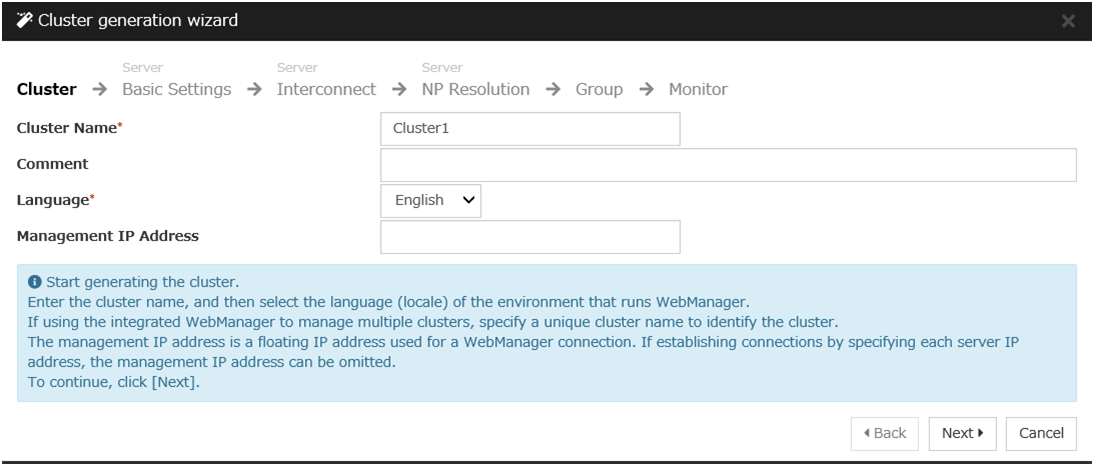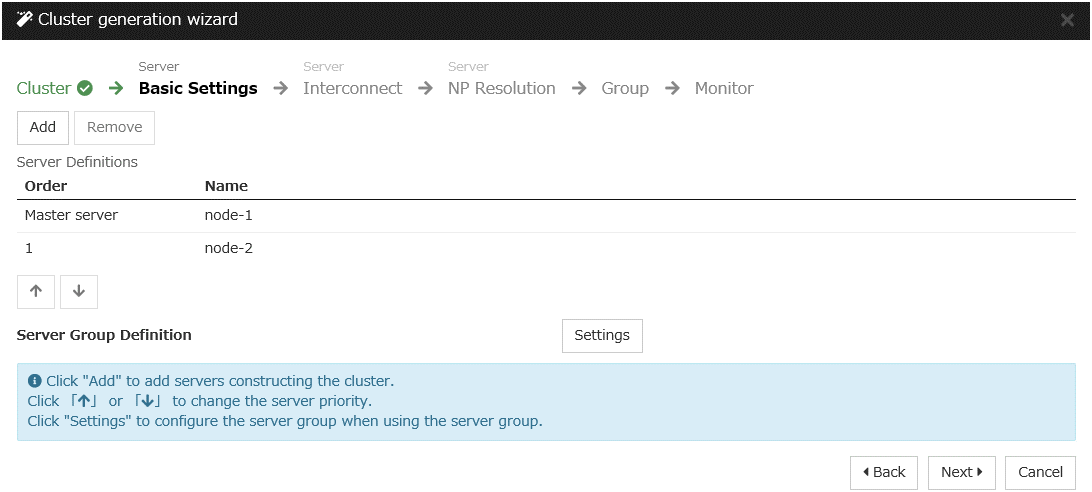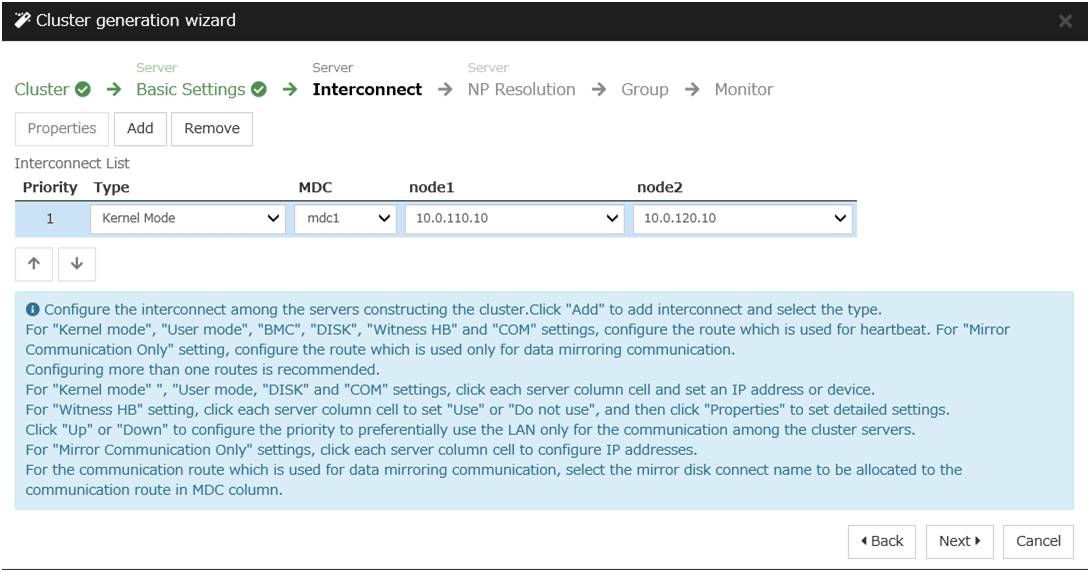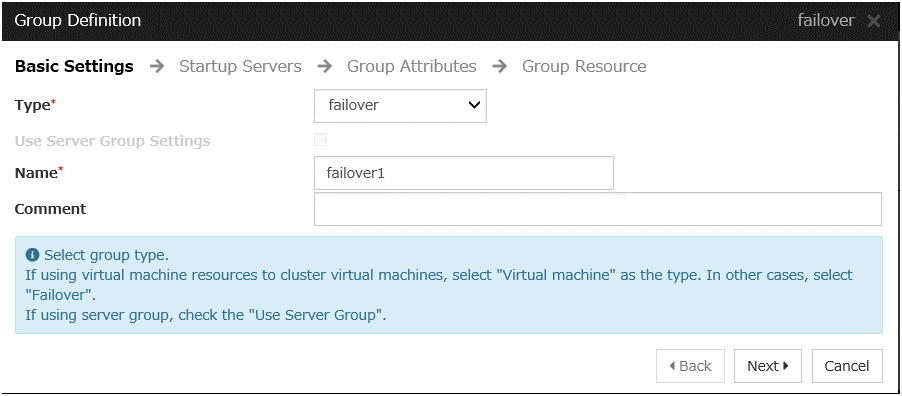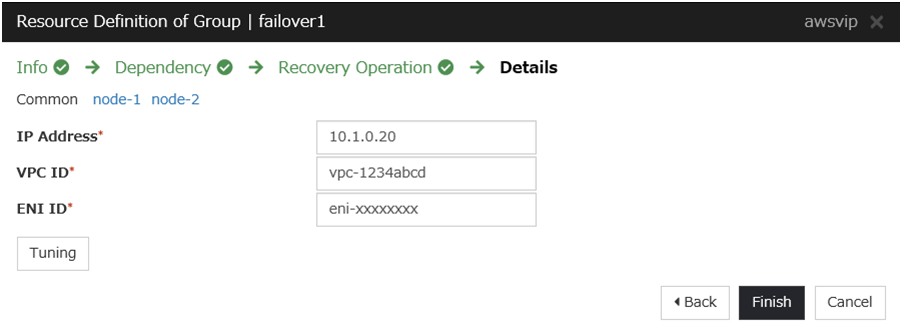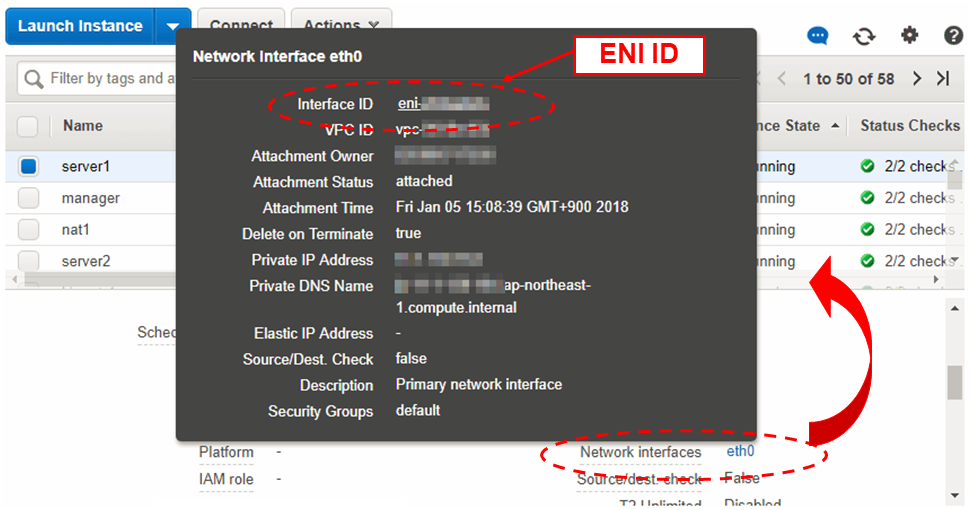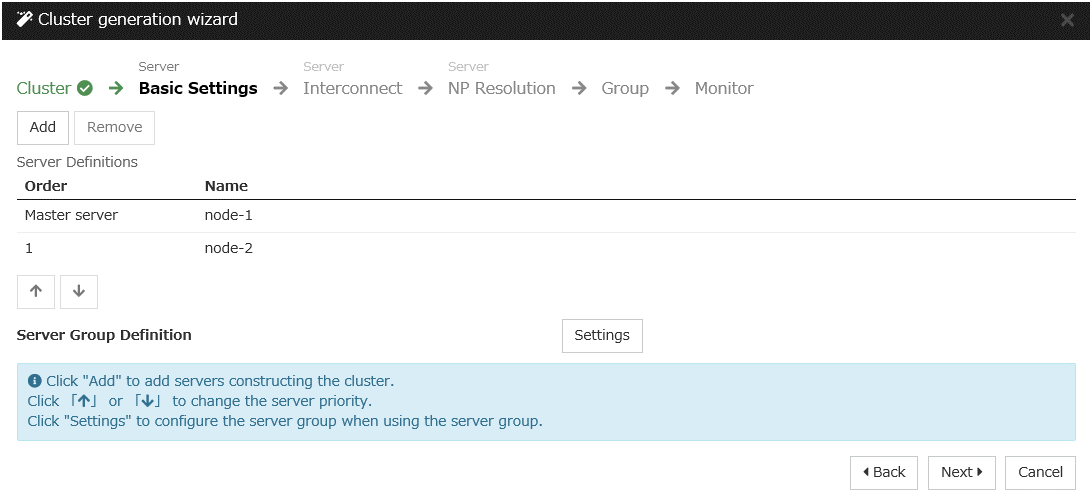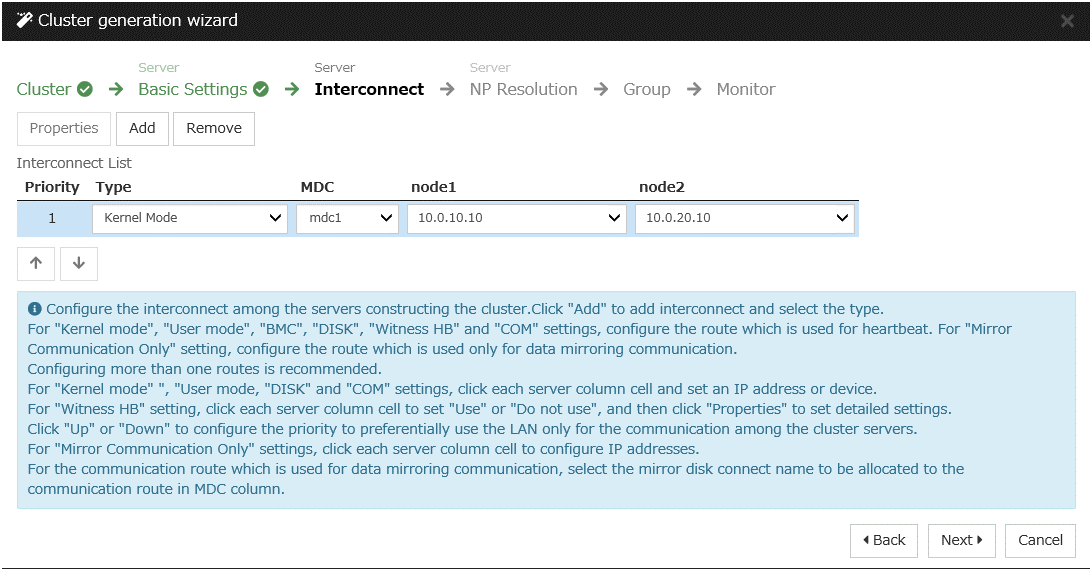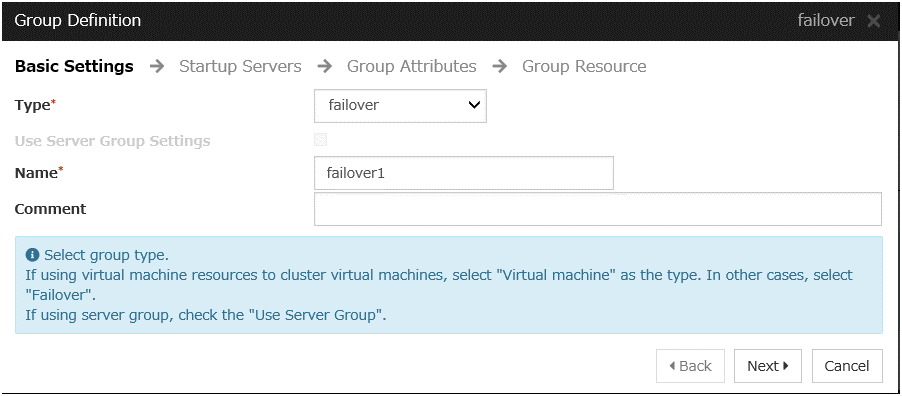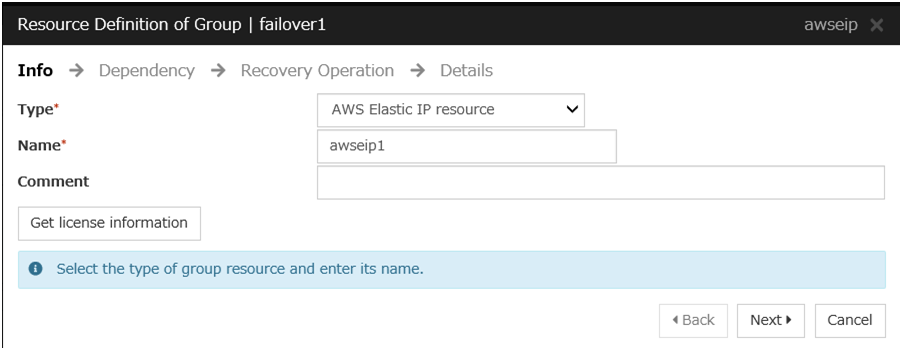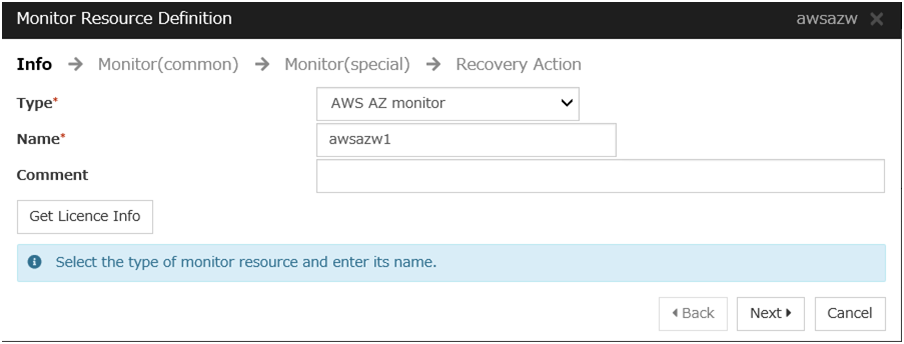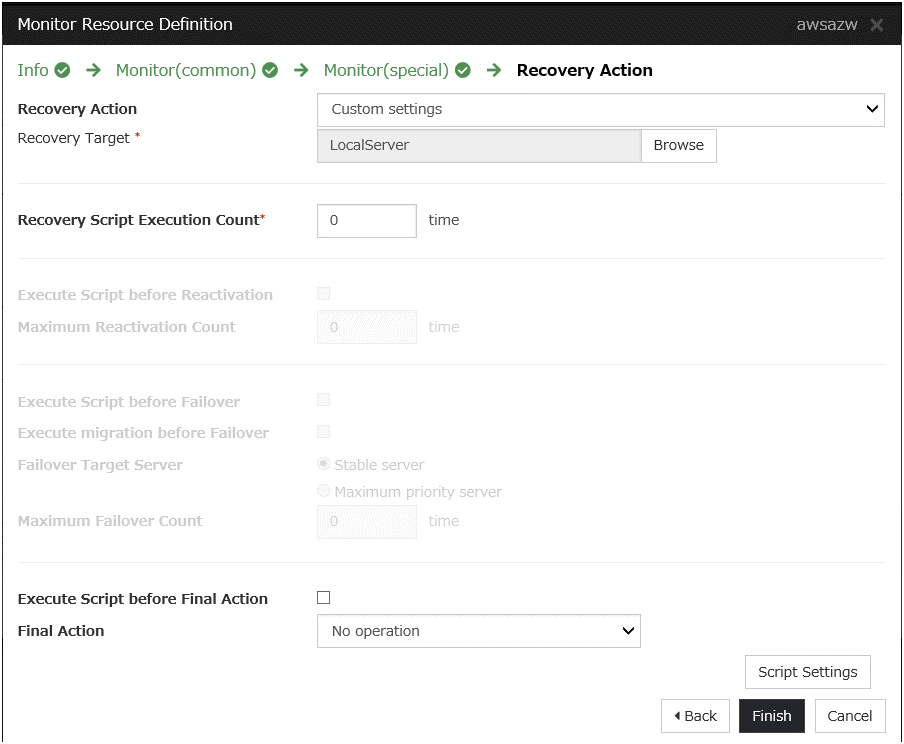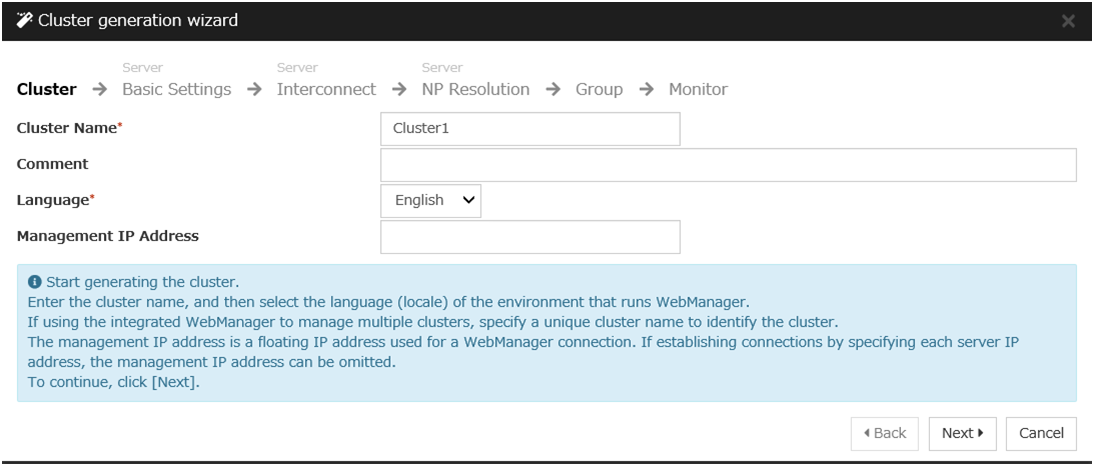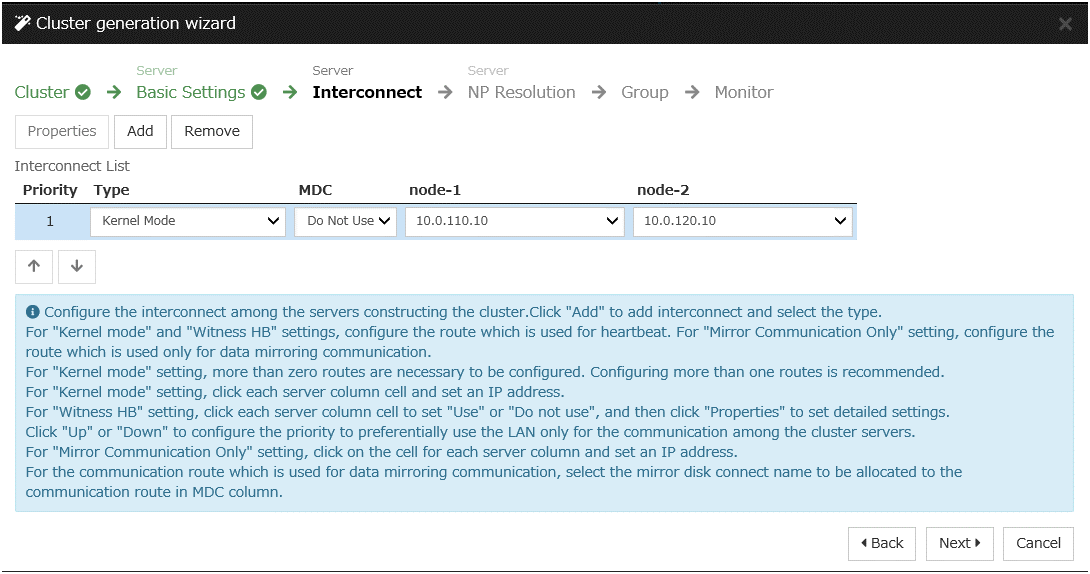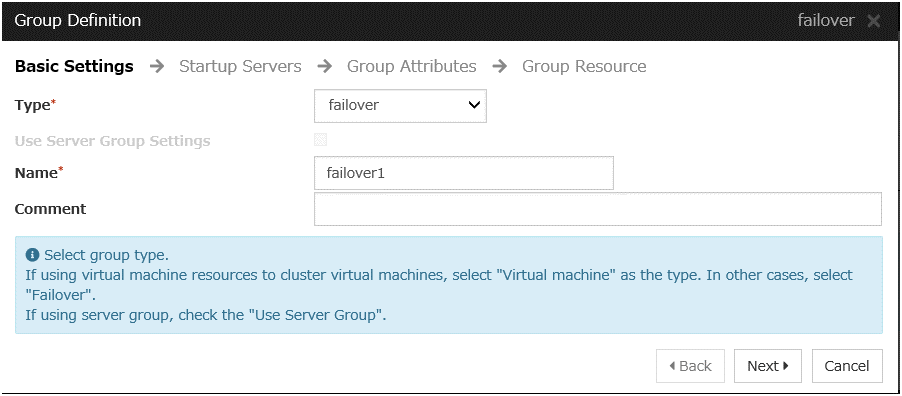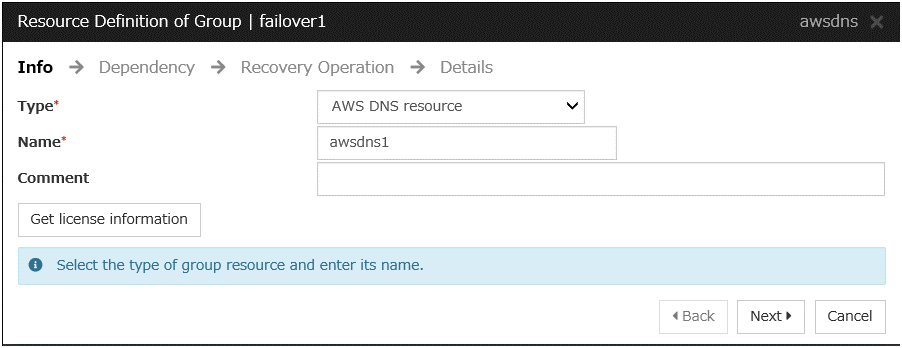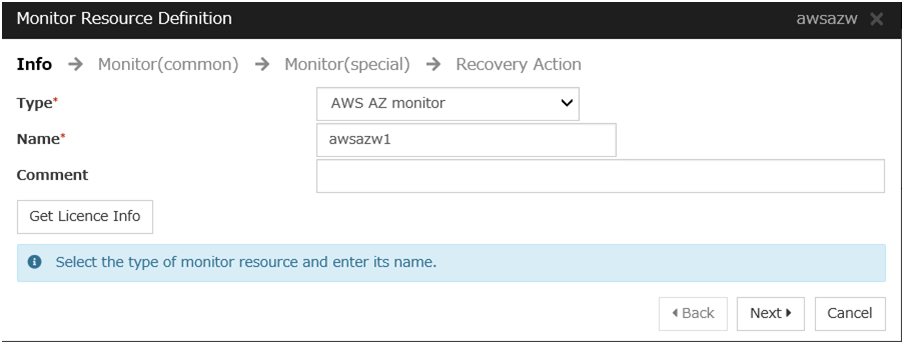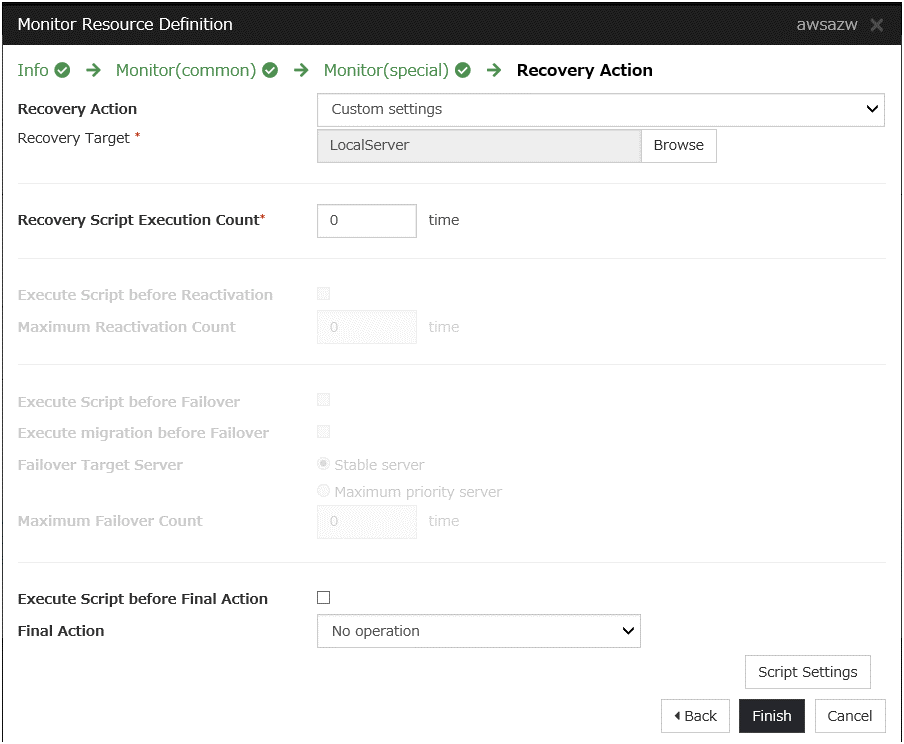1. Preface¶
1.1. Who Should Use This Guide¶
This guide is intended for administrators who configure cluster systems, and system engineers and maintenance staff who support the users. They must also have knowledge of Amazon EC2, Amazon VPC, and IAM provided by Amazon Web Services.
1.2. Scope of Application¶
For information on the system requirements, see "Getting Started Guide" -> "Installation requirements for EXPRESSCLUSTER".
This guide contains product- and service-related information (e.g., screenshots) collected at the time of writing this guide. For the latest information, which may be different from the content in this guide, refer to corresponding websites and manuals.
1.3. How This Guide is Organized¶
3. Operating Environment: Describes the tested operating environment of this function.
5. Constructing an HA cluster based on VIP control: Describes how to create an HA cluster based on VIP control.
6. Constructing an HA cluster based on EIP control: Describes how to create an HA cluster based on EIP control.
7. Constructing an HA cluster based on DNS name control: Describes how to create an HA cluster based on DNS name control.
8. Troubleshooting: Describes the problems and their solutions.
1.4. EXPRESSCLUSTER X Documentation Set¶
The EXPRESSCLUSTER X manuals consist of the following four guides. The title and purpose of each guide is described below:
EXPRESSCLUSTER X Getting Started Guide
This guide is intended for all users. The guide covers topics such as product overview, system requirements, and known problems.
EXPRESSCLUSTER X Installation and Configuration Guide
This guide is intended for system engineers and administrators who want to build, operate, and maintain a cluster system. Instructions for designing, installing, and configuring a cluster system with EXPRESSCLUSTER are covered in this guide.
EXPRESSCLUSTER X Reference Guide
This guide is intended for system administrators. The guide covers topics such as how to operate EXPRESSCLUSTER, function of each module and troubleshooting. The guide is supplement to the Installation and Configuration Guide.
EXPRESSCLUSTER X Maintenance Guide
This guide is intended for administrators and for system administrators who want to build, operate, and maintain EXPRESSCLUSTER-based cluster systems. The guide describes maintenance-related topics for EXPRESSCLUSTER.
1.5. Conventions¶
In this guide, Note, Important, See also are used as follows:
Note
Used when the information given is important, but not related to the data loss and damage to the system and machine.
Important
Used when the information given is necessary to avoid the data loss and damage to the system and machine.
See also
Used to describe the location of the information given at the reference destination.
The following conventions are used in this guide.
Convention |
Usage |
Example |
|---|---|---|
Bold |
Indicates graphical objects, such as text boxes, list boxes, menu selections, buttons, labels, icons, etc. |
Click Start.
Properties dialog box
|
Angled bracket within the command line |
Indicates that the value specified inside of the angled bracket can be omitted. |
|
> |
Prompt to indicate that a Windows user has logged on as root user. |
|
Monospace |
Indicates path names, commands, system output (message, prompt, etc.), directory, file names, functions and parameters. |
|
bold |
Indicates the value that a user actually enters from a command line. |
Enter the following:
> clpcl -s -a
|
|
Indicates that users should replace italicized part with values that they are actually working with. |
|
 In the figures of this guide, this icon represents EXPRESSCLUSTER.
In the figures of this guide, this icon represents EXPRESSCLUSTER.
2. Overview¶
2.1. Functional overview¶
The settings described in this guide allow you to construct an HA cluster with EXPRESSCLUSTER in the Amazon Virtual Private Cloud (VPC) environment provided by Amazon Web Services (AWS).
Because more important applications can be performed by constructing an HA cluster, a wider range of system configuration options are available in the AWS environment. The AWS has a robust configuration made up of multiple availability zones (hereafter referred to as AZ) in each region. The user can select and use an AZ as needed. EXPRESSCLUSTER realizes highly available applications by allowing the HA cluster to operate between multiple AZs in a region (hereafter referred to as Multi-AZ).
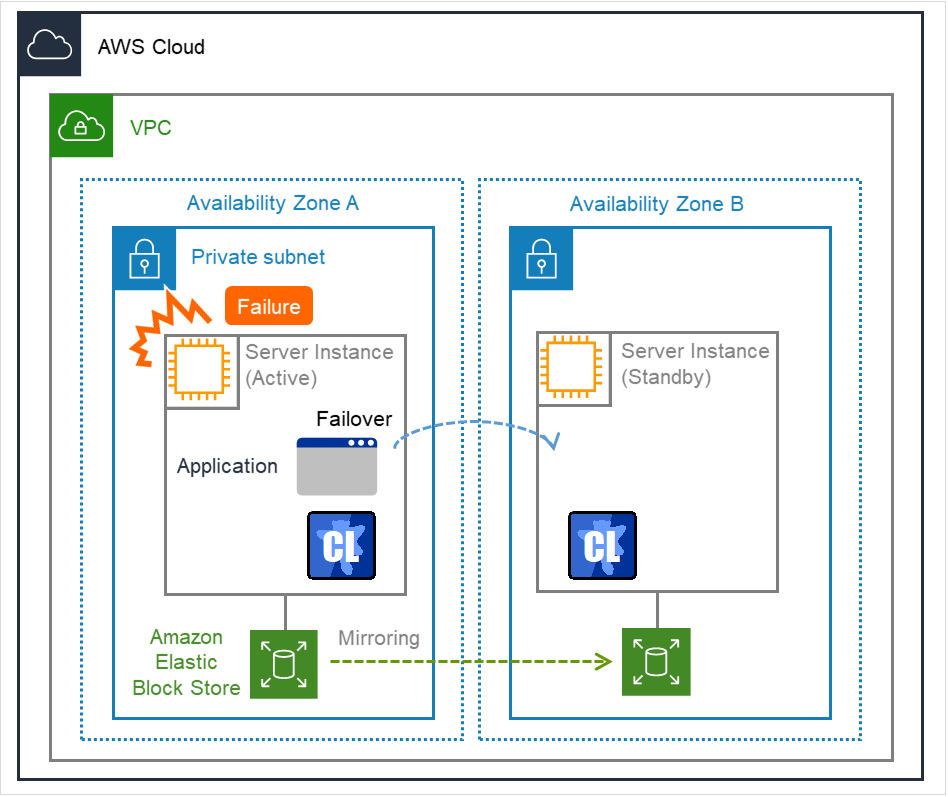
Fig. 2.1 Mirror Type HA Cluster in Multi-AZ Configuration¶
In the AWS environment, a virtual IP can be used to connect to the cluster server. The AWS Virtual IP resource, AWS Elastic IP resource and AWS DNS resource enable the client not to be aware of switching the destination server even if a "failover" or "group transition" occurred.
2.2. HA cluster configuration¶
This guide describes three types of HA cluster configurations: HA cluster based on virtual IP (VIP) control, HA cluster based on elastic IP (EIP) control and HA cluster based on DNS name control. This section describes a single AZ configuration. For a multi-AZ configuration, refer to "2.3. Multi-AZ"
Location of a client accessing an HA cluster |
Resource to be selected |
Reference in this chapter |
|---|---|---|
In the same VPC |
AWS Virtual IP resource |
HA cluster based on VIP control |
Internet |
AWS Elastic IP resource |
HA cluster based on EIP control |
Voluntary location |
AWS DNS resource |
HA cluster based on DNS name control |
2.2.1. HA cluster based on VIP control¶
This guide assumes the configuration in which a client in the same VPC accesses an HA cluster via a VIP address. For example, a DB server is clustered and accessed from a web server via a VIP address.
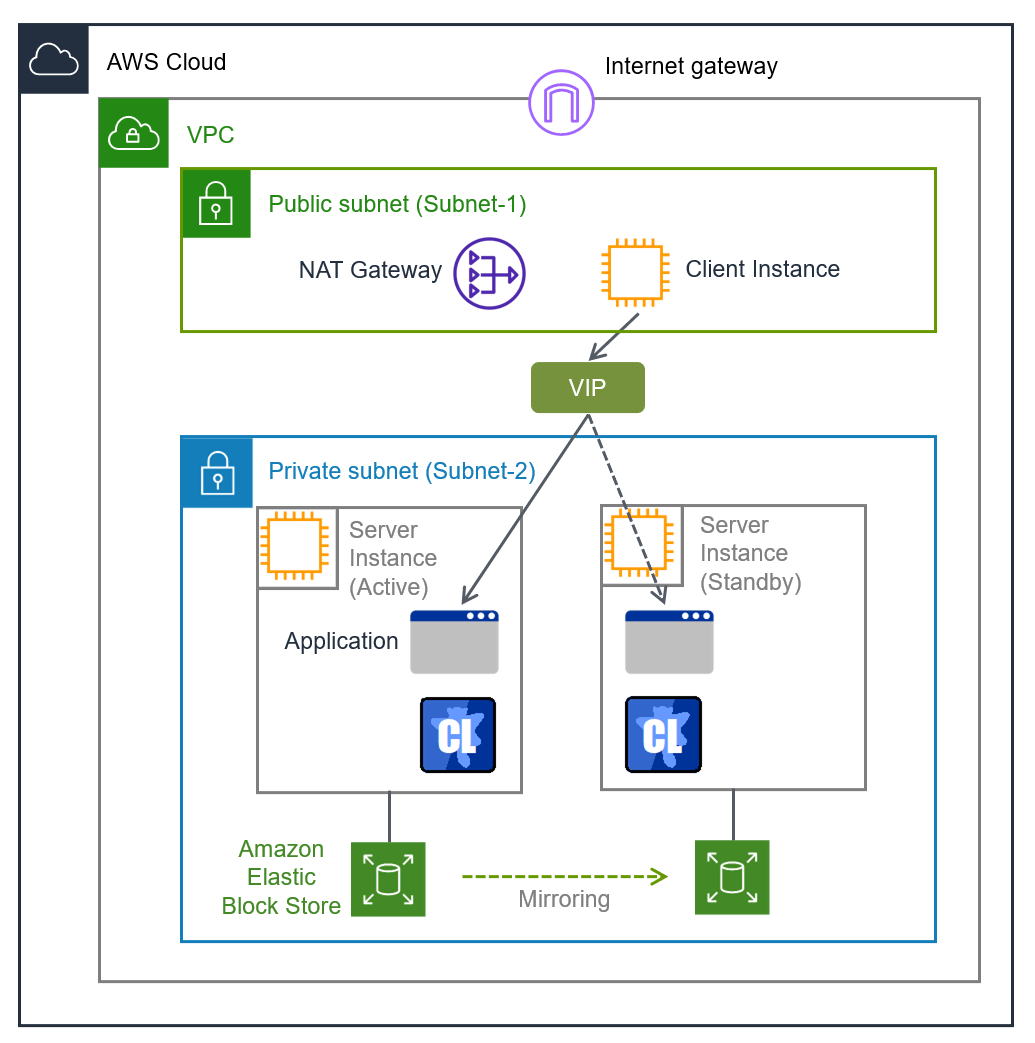
Fig. 2.2 HA Cluster Based on VIP Control¶
In the above figure, the server instances are clustered and placed on the private subnet. The AWS Virtual IP resource of EXPRESSCLUSTER sets a VIP address to the active server instance and rewrites the VPC route table. This enables the client instance placed on any subnet in the VPC to access the active server instance via the VIP address. The VIP address must be out of the VPC CIDR range.
To enable a client outside the VPC to access the server instance, establish the communication by using the route table in the VPC in some way. For example, using AWS Transit Gateway enables the communication from outside the VPC to be transferred to the VPC via the Transit Gateway route table and then to be established with the server instance via the route table in the VPC.
The following resources and monitor resources are required for an HA cluster based on VIP control configuration.
Resource type |
Description |
Setup |
|---|---|---|
AWS Virtual IP resource |
Assigns a VIP address to an active server instance, changes the route table of the assigned VIP address, and publishes operations within the VPC. |
Required |
AWS Virtual IP monitor resource |
Periodically monitors whether the VIP address assigned by the AWS Virtual IP resource exists in the local server and whether the VPC route table is changed illegally.
(This monitor resource is automatically added when the AWS Virtual IP resource is added.)
|
Required |
AWS AZ monitor resource |
Periodically monitors the health of the AZ in which the local server exists by using Multi-AZ. |
Recommended |
Other resources and monitor resources |
Depends on the configuration of the application, such as a mirror disk, used in an HA cluster. |
Optional |
2.2.2. HA cluster based on EIP control¶
This guide assumes the configuration in which a client accesses an HA cluster via a global IP address assigned to the EIP through the Internet.
Clustered instances are placed on a public subnet. Each instance can access the Internet via the Internet gateway.
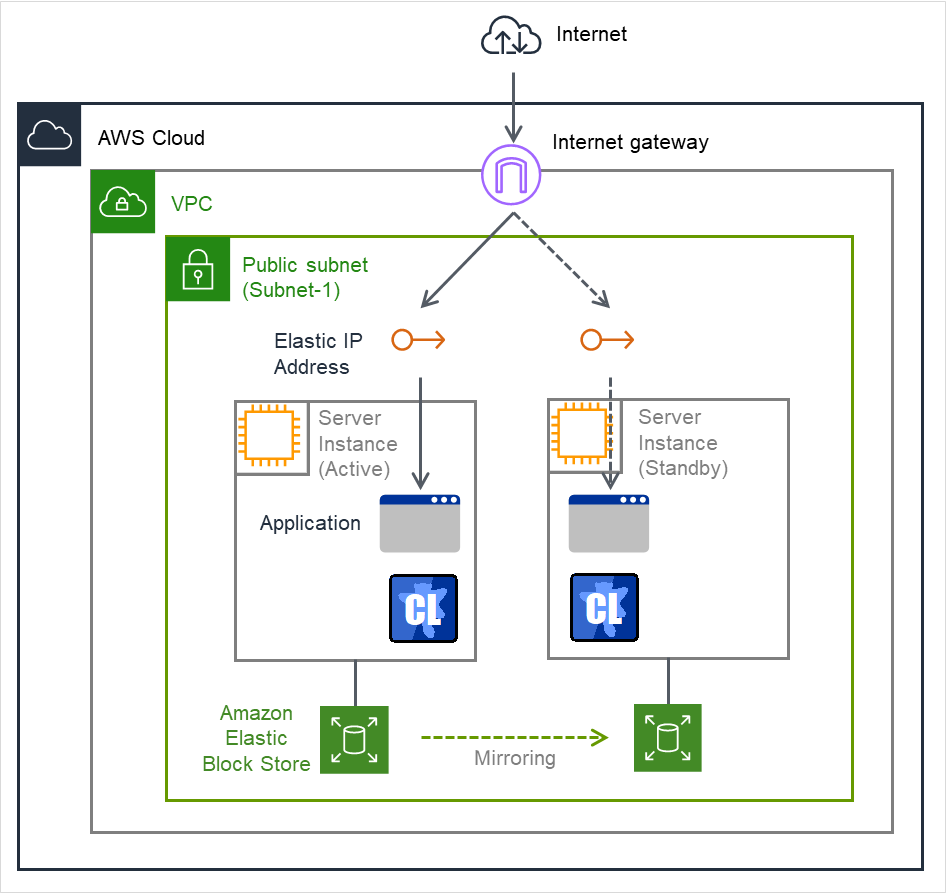
Fig. 2.3 HA Cluster Based on EIP Control¶
The following resources and monitor resources are required for an HA cluster based on EIP control configuration.
Resource type |
Description |
Setup |
|---|---|---|
AWS Elastic IP resource |
Assigns an EIP address to an active server instance and publishes operations to the Internet. |
Required |
AWS Elastic IP monitor resource |
Periodically monitors whether the EIP address assigned by the AWS Elastic IP resource exists in the local server.
(This monitor resource is automatically added when the AWS Elastic IP resource is added.)
|
Required |
AWS AZ monitor resource |
Periodically monitors the health of the AZ in which the local server exists by using Multi-AZ. |
Recommended |
Other resources and monitor resources |
Depends on the configuration of the application, such as a mirror disk, used in an HA cluster. |
Optional |
2.2.3. HA cluster based on DNS name control¶
This guide assumes the configuration in which a client accesses an HA cluster via the same DNS name. For example, a DB server is clustered and accessed from a web server via a DNS name.

Fig. 2.4 HA cluster based on DNS name control¶
In the above figure, the server instances are clustered and placed on the private subnet. The AWS DNS resource of EXPRESSCLUSTER registers resource record set including the DNS name and the IP address of the active server into the Private Hosted Zone of Amazon Route 53. This enables the client instance placed on any subnet in the VPC to access the active server instance via the DNS name.
In this guide, clustered server instances are placed on the private subnet. However, the instances can be also placed on a public subnet. In this case, this enables a client on the Internet to access the active server instance via the DNS name by registering the resource record set including the DNS name and the public IP address of the active server into the Public Hosted Zone of Amazon Route 53. Furthermore, in order that the query to the domain of the Public Hosted Zone can refer to the Amazon Route 53 name server, it is required to set the name server (NS) record of the registrar in advance.
Moreover, for a configuration in which the cluster and client exist in different VPCs, use a VPC peering connection. Preliminary create a peering connection between the VPCs and associate the VPCs with the private hosted zone of Amazon Route 53. And then register the resource record set including the DNS name and the IP address of the active server into the private hosted zone. This enables the client in the different VPC to access the active server instance via DNS name.
The table below shows the necessary resources and monitor resources for constructing a HA cluster based on DNS name control.
Resource Type |
Description |
Configuration |
|---|---|---|
AWS DNS resource |
Registers the resource record sets including the DNS name and the IP address of the active server instance into the hosted zone of Amazon Route 53, and publishes operations within the VPC or to the Internet. |
Required |
AWS DNS monitor resource |
AWS DNS resource periodically monitors whether the registered resource record set exists in the hosted zone of Amazon Route 53 and whether the resolution of the DNS name is available.
(This monitor resource is automatically added when the AWS DNS resource is added.)
|
Required |
AWS AZ monitor resource |
Periodically monitors the health of the AZ in which the local server exists by using Multi-AZ. |
Recommended |
Other resources and monitor resources |
Depends on the configuration of the application, such as a mirror disk, used in an HA cluster. |
Optional |
2.3. Multi-AZ¶
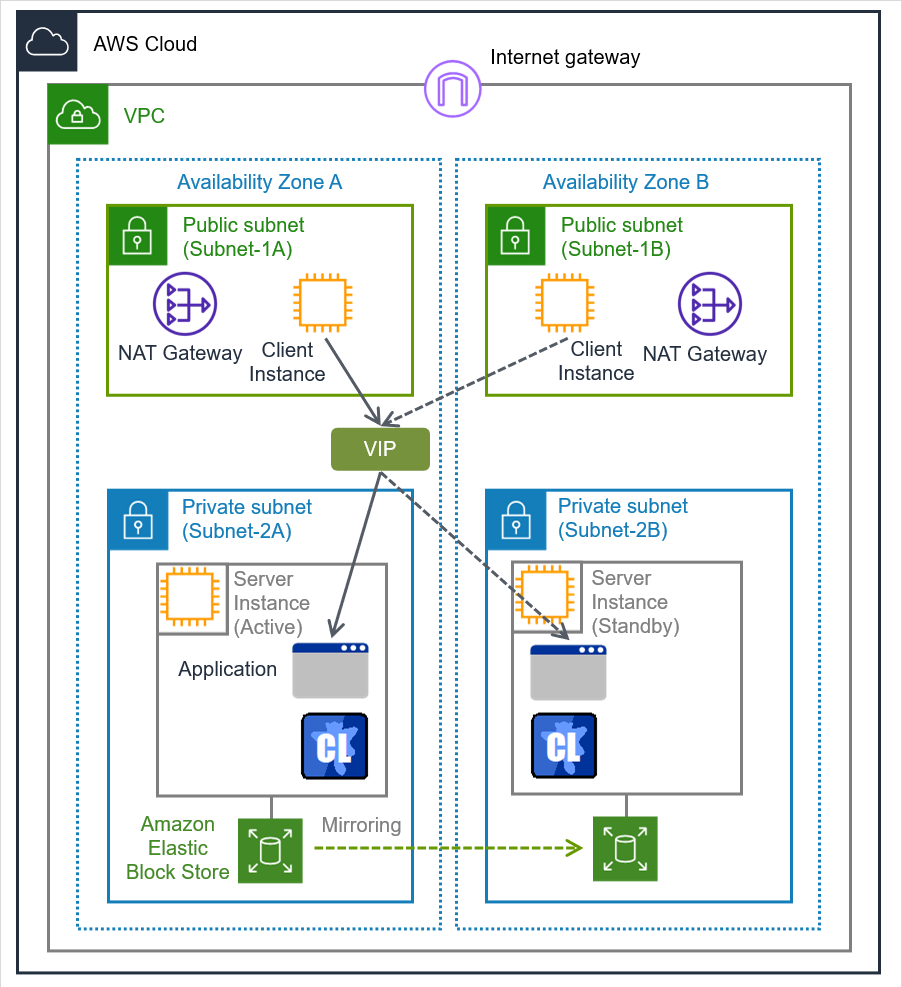
Fig. 2.5 HA Cluster Using Multi-AZ¶
2.4. Network partition resolution¶
In network partition resolution (NP resolution), each server checks whether it can access a shared device or not, and then determines whether the server has been isolated from the network or other servers have been down.
The following table shows NP resolution configured for examples in this guide (unspecified settings mean that their default values are used):
Item |
Setting |
Remark |
|---|---|---|
Type |
HTTP |
|
Target Host
(Target)
|
aws.amazon.com |
Specify a device which responds to an HTTP HEAD request with the status code 200. |
Service Port |
443 |
|
Use SSL |
On |
To specify the 443 port of aws.amazon.com as the target, set this setting to On. |
For more information on NP resolution, refer to the following documents:
2.5. On-premises and AWS¶
The following table describes the EXPRESSCLUSTER functional differences between the on-premises and AWS environments.
✓: Available
n/a: Not available
Function |
On-premises |
AWS |
|---|---|---|
Creation of a shared disk type cluster |
✓ |
✓ |
Creation of a mirror disk type cluster |
✓ |
✓ |
Using the management group |
✓ |
n/a |
Floating IP resource |
✓ |
n/a |
Virtual IP resource |
✓ |
n/a |
Virtual computer name resource |
n/a |
✓ |
AWS elastic ip resource |
n/a |
✓ |
AWS virtual ip resource |
n/a |
✓ |
Possibility of using AWS DNS resource |
n/a |
✓ |
The following table describes the creation flow of a 2-node cluster that uses a mirror disk and IP alias (on-premises: floating IP resource, AWS: AWS virtual ip resource) in the on-premises and AWS environments.
Before installing EXPRESSCLUSTER
Step
On-premises
AWS
1
Configure the VPC environment.
Not required
- When using the AWS Virtual IP resource, refer to "5.1. Configuring the VPC Environment" in this guide.- When using the AWS Elastic IP resource, refer to "6.1. Configuring the VPC Environment" in this guide.- When AWS DNS resource is used, refer to "7.1. Configuring the VPC Environment" in this guide.2
Configure the instance.
Not required
- When using the AWS Virtual IP resource, refer to "5.2. Configuring the instance" in this guide.- When using the AWS Elastic IP resource, refer to "6.2. Configuring the instance" in this guide.- When AWS DNS resource is used, refer to "7.2. Configuring the instance" in this guide.3
Configure a partition for a mirror disk resource.
Refer to the following:Same as the on-premises environment
4
Adjust the OS startup time.
Refer to the following:Same as the on-premises environment
5
Check the network.
Refer to the following:Same as the on-premises environment
6
Check the firewall.
Refer to the following:Same as the on-premises environment
7
Synchronize the server time.
Refer to the following:Same as the on-premises environment
8
Install EXPRESSCLUSTER.
Same as the on-premises environment
After installing EXPRESSCLUSTER
Step
On-premises
AWS
9
Register the EXPRESSCLUSTER license.
Same as the on-premises environment
10
Construct a cluster - Set up the heartbeat method.
Refer to the following:BMC heartbeat and DISK heartbeat cannot be used.
11
Construct a cluster: Set up the NP resolution.
Use an NP resolution resource.Refer to the following:Use an NP resolution resource.Refer to the following section of this guide:12
Construct a cluster: Create a failover groupCreate a monitor resource.Refer to the following:In addition to the reference for the on-premises environment, refer to the following:- When using the AWS virtual ip resource- "5.3. Setting up EXPRESSCLUSTER" in this guide- When using the AWS Elastic IP resource, refer to the following:- "6.3. Setting up EXPRESSCLUSTER" in this guide- When using the AWS DNS resource, refer to the following:- "7.3. Setting up EXPRESSCLUSTER" in this guide
4. Notes¶
4.1. Notes on Using EXPRESSCLUSTER in the VPC¶
Note the following points when using EXPRESSCLUSTER in the VPC environment.
Access from the Internet or different VPC
NEC has verified that the AWS specifications do not allow clients on the internet or different VPC to access the server instance via the VIP address assigned by the AWS Virtual IP resource. In case of accessing from the client on Internet, specify the EIP address assigned by the AWS Elastic IP resource. In case of accessing from the client on different VPC, specify the DNS name registered to Amazon Route 53 with AWS DNS resource and then make an access via VPC Peering Connection.
Access from different VPC via VPC peering connection
AWS Virtual IP resources cannot be used if access via a VPC peering connection is necessary. This is because it is assumed that an IP address to be used as a VIP is out of the VPC range and such an IP address is considered invalid in a VPC peering connection. If access via a VPC peering connection is necessary, use the AWS DNS resource that use Amazon Route 53.
Using VPC endpoint
By using VPC endpoint, it is able to control Amazon EC2 services of AWS CLI without preparing proxy server or NAT, even on the private network. Therefore, in the case of "5. Constructing an HA cluster based on VIP control", it is able to use VPC endpoint instead of NAT. When the VPC endpoint is created, the name which ends in ".ec2" must be selected.
Moreover, even when VPC endpoint is used, NAT gateway etc. will be required if internet access (for online update of instance, module download etc.) or access to AWS cloud service which is not supported by VPC endpoint are needed.
For EXPRESSCLUSTER, the VPC endpoint cannot be explicitly specified.Use the VPC endpoint automatically selected by the AWS CLI.
Restrictions on the group resource and monitor resource functions
Mirror disk performance
If an HA cluster is constructed in a Multi-AZ configuration, the instances are located at long distances from each other, causing a TCP/IP response delay. This might affect a mirroring operation.Also, the usage of other systems affects the mirroring performance due to multi-tenancy. Therefore, the difference in the mirror disk performance in a cloud environment tends to be larger than that in a physical or general virtualized environment (non-cloud environment) (that is, the degradation rate of the mirror disk performance tends to be larger).Take this point into consideration at the design phase if priority is put on writing performance in your system.
Shutting down OS from the outside of cluster
In the AWS environment, it is technically possible to shutdown OS (stop the instance) from the outside of cluster by using EC2 Management Console, CLI etc.However, if it is done, the process of stopping the cluster may not be completed properly.In order to avoid this problem, please use clpstdncnf command. For details of the clpstdncnf command, refer to the following:However, in the AWS environment, if it takes a long time to shutdown OS from EC2 Management Console, AWS CLI etc., AWS may stop the instance forcibly.AWS does not publish the time which elapses before stopping the instance forcibly, and the time cannot be changed.
The influence of the stoppage of AWS endpoint
The AWS DNS monitor resource uses AWS CLI in order to check the existence of the resource record set.To prevent a failover caused by an AWS endpoint under maintenance or failure or by a network path under delay constraint or failure, go to Action when AWS CLI command failed to receive response of the AWS DNS monitor resource and select either Disable recovery action(Display warning) or Disable recovery action(Do nothing).If the warning frequently appears, it is recommended to select Disable recovery action(Do nothing).
5. Constructing an HA cluster based on VIP control¶
In the figure below, "Server Instance (Active)" and "Server Instance (Standby)" respectively represent the instance of the active server and that of the standby server.
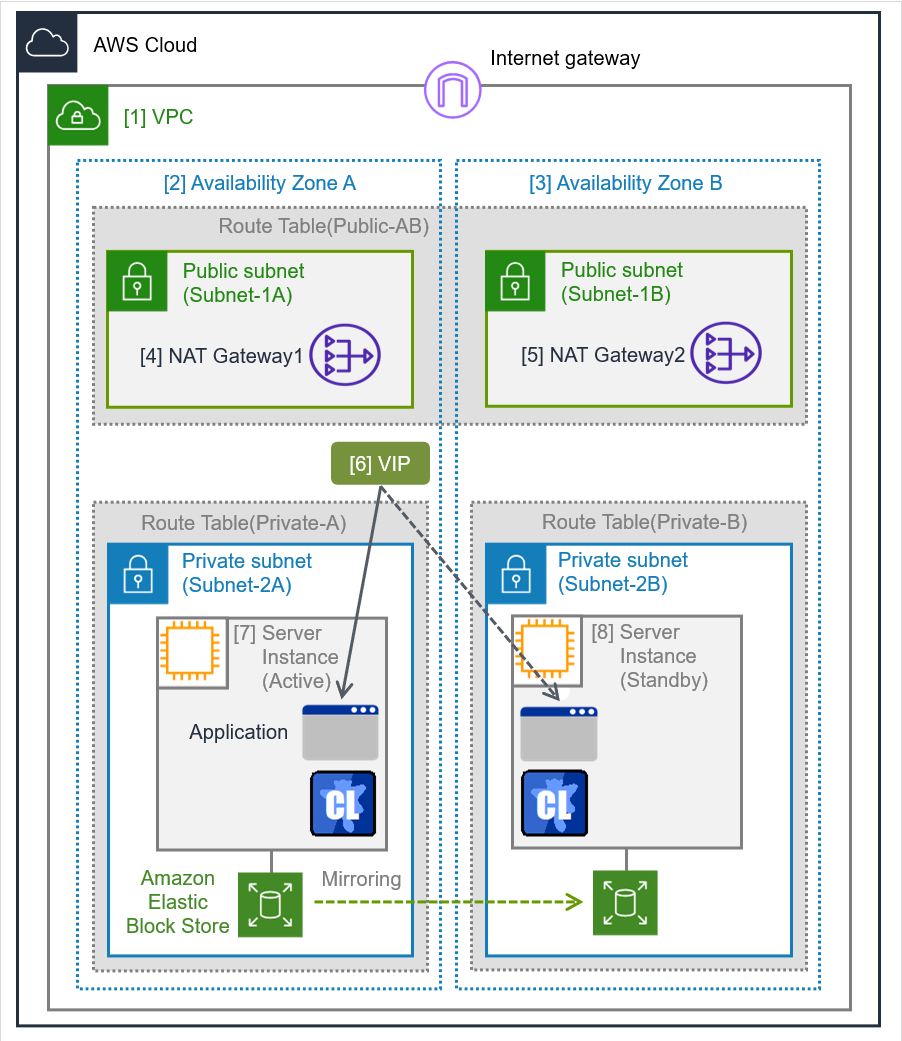
Fig. 5.1 System Configuration of the HA Cluster Based on VIP Control¶
CIDR (VPC) |
10.0.0.0/16 |
|---|---|
VIP |
10.1.0.20 |
Public subnet (Subnet-1A) |
10.0.10.0/24 |
Public subnet (Subnet-1B) |
10.0.20.0/24 |
Private subnet (Subnet-2A) |
10.0.110.0/24 |
Private subnet (Subnet-2B) |
10.0.120.0/24 |
5.1. Configuring the VPC Environment¶
Configure the VPC and subnet.
Create a VPC and subnet first.
-> Add a VPC and subnet in VPC and Subnets on the VPC Management console.
- [1] VPC
- Write down the VPC ID (vpc-xxxxxxxx), which is needed later for setting up the AWS virtual IP resource.
Configure the Internet gateway.
Add an Internet gateway to access the Internet from the VPC.
-> To create an Internet gateway, select Internet Gateways > Create internet gateway on the VPC Management console. Attach the created Internet gateway to the VPC.
Configure the network ACL and security group.
Specify the appropriate network ACL and security group settings to prevent unauthorized network access from in and out of the VPC.Change the network ACL and security group path settings so that the instances of the HA cluster node can communicate with the Internet gateway via HTTPS, communicate with Cluster WebUI, and communicate with each other. The instances are to be placed on the private networks (Subnet-2A and Subnet-2B).-> Change the settings in Network ACLs and Security Groups on the VPC Management console.
For the port numbers that are used by the EXPRESSCLUSTER components, refer to the following:
Add an HA cluster instance.
Create an HA cluster node instance on the private networks (Subnet-2A and Subnet-2B).To use an IAM role by assigning it to an instance, specify the IAM role.-> To create an instance, select Instances > Launch Instance on the EC2 Management console.
-> For details about the IAM settings, refer to the following:
Disable Source/Dest. Check of the elastic network interface (ENI) assigned to each created instance.To perform the VIP control by using the AWS virtual ip resource, communication with the VIP address (10.1.0.20 in the above figure) must be routed to the ENI of the instance. It is necessary to disable Source/Dest. Check of the ENI of each instance to communicate with the private IP address and VIP address.-> To change the settings, right-click the added instance in Instances on the EC2 Management console, and select Networking > Change Source/Dest. Check.
- [7] Server Instance (Active), [8] Server Instance (Standby)
- The ENIs assigned respectively to the instance of the active server and the instance of the standby server can be identified according to the ENI IDs.Write down the ENI ID (eni-xxxxxxxx) of each instance, because the ID is needed later for setting up the AWS virtual IP resource.
Use the following procedure to check the ENI ID assigned to the instance.
Select the instance to display its detailed information.
Click the target device in Network Interfaces.
Check Interface ID displayed in the pop-up window.
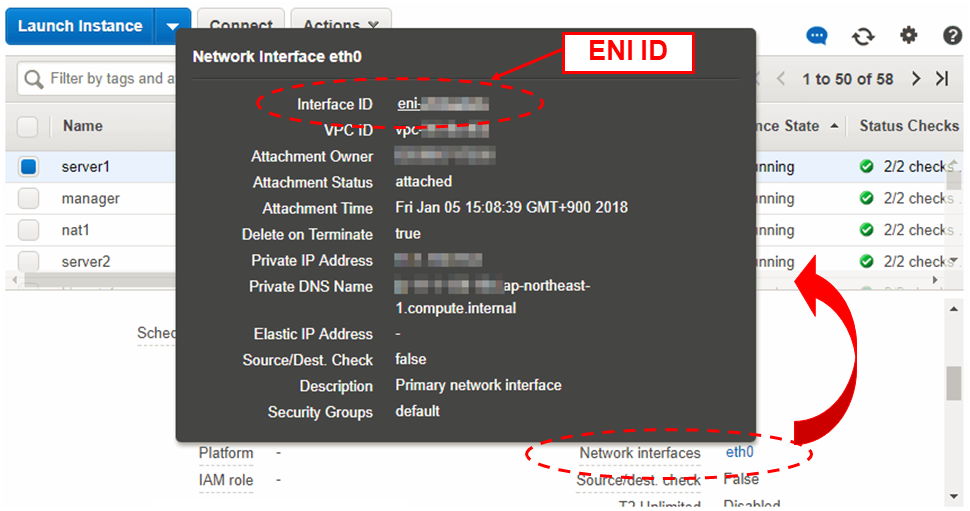
Add a NAT.
To perform the VIP control by using the AWS CLI, communication from the instance of the HA cluster node to the regional endpoint via HTTPS must be enabled.To do so, create a NAT gateway on the public networks (Subnet-1A and Subnet-1B).For more information on the NAT gateway, see the corresponding AWS document.Configure the route table.
Add the routing to the Internet gateway so that the AWS CLI can communicate with the regional endpoint via NAT and the routing so that a client in the VPC can access the VIP address. The number of CIDR blocks of the VIP address must always be 32.
The following routings must be set in the route table (Public-AB) of the public networks (Subnet-1A and Subnet-1B in the above figure).
Route table (Public-AB)
Destination
Target
Remarks
VPC network(Example: 10.0.0.0/16)localExisting by default0.0.0.0/0
Internet gateway
Add (required)
VIP address(Example: 10.1.0.20/32)eni-xxxxxxxx(ENI ID of the active server instance represented as "[7] Server Instance (Active)")Add (required)
The following routings must be set in the route tables (Private-A and Private-B) of the private networks (Subnet-2A and Subnet-2B in the above figure).
Route table (Private-A)
Destination
Target
Remarks
VPC network(Example: 10.0.0.0/16)localExisting by default0.0.0.0/0
NAT Gateway1
Add (required)
VIP address(Example: 10.1.0.20/32)eni-xxxxxxxx(ENI ID of the active server instance represented as "[7] Server Instance (Active)")Add (required)Route table (Private-B)
Destination
Target
Remarks
VPC network(Example: 10.0.0.0/16)localExisting by default0.0.0.0/0
NAT Gateway2
Add (required)
VIP address(Example: 10.1.0.20/32)eni-xxxxxxxx(ENI ID of the active server instance represented as "[7] Server Instance (Active)")Add (required)
When a failover occurred, the AWS Virtual IP resource switches all routings to the VIP address set in these route tables to the ENI of the standby server instance by using the AWS CLI.
- [6] VIP
- The VIP address must be out of the VPC CIDR range of the VPC.Write down the VIP address set to the route table, because the address is needed later for setting up the AWS virtual IP resource.
Configure other routings according to the environment.
Add a mirror disk (EBS).
Add an EBS to be used as the mirror disk (cluster partition or data partition) as needed.
-> To add an EBS, select Volumes > Create Volume on the EC2 Management console, and then attach the created volume to an instance.
5.2. Configuring the instance¶
Configure a firewall.
Change the firewall setting as needed.For the port numbers that are used by the EXPRESSCLUSTER components, refer to the following:Install the AWS CLI.
Download and install the AWS CLI.The installer automatically adds the path of the AWS CLI to the system environment variable PATH. If the automatic path addition fails, refer to "AWS Command Line Interface" of the AWS document to add the path.If the AWS CLI has been installed in an environment with EXPRESSCLUSTER already installed, restart the OS before operating EXPRESSCLUSTER.Register the AWS access key ID.
Start the command prompt as the Administrator user and run the following command:
> aws configure
Enter information such as the AWS access key ID to the inquiries.
The settings to be specified vary depending on whether an IAM role is assigned to the instance or not.
Instance to which an IAM role is assigned.
AWS Access Key ID [None]: (Press Enter without entering anything.) AWS Secret Access Key [None]: (Press Enter without entering anything.) Default region name [None]: <default region name> Default output format [None]: text
Instance to which an IAM role is not assigned.
AWS Access Key ID [None]: <AWS access key ID> AWS Secret Access Key [None]: <AWS secret access key> Default region name [None]: <default region name> Default output format [None]: text
For "Default output format", other format than "text" may be specified.If you specified incorrect settings, delete the folder%SystemDrive%\Users\Administrator\.awsentirely, and specify the above settings again.Prepare the mirror disk.
If an EBS has been added to be used as the mirror disk, divide the EBS into partitions and use each partition as the cluster partition and data partition.For details about the mirror disk partition, refer to the following:Install EXPRESSCLUSTER.
For the installation procedure, refer to "Installation and Configuration Guide".Store the EXPRESSCLUSTER installation media in the environment to which to install EXPRESSCLUSTER.(To transfer data, use any method such as Remote Desktop and Amazon S3.)After the installation, restart the OS.
5.3. Setting up EXPRESSCLUSTER¶
For details about how to set up and connect to Cluster WebUI, refer to the following:
This section describes how to add the following resources:
Mirror disk resource
AWS Virtual IP resource
AWS AZ monitor resource
AWS Virtual IP monitor resource
NP resolution (HTTP method)
For the settings other than the above, refer to "Installation and Configuration Guide ".
Construct a cluster.
Start the cluster generation wizard to construct a cluster.
Construct a cluster.
Steps
Add a group resource.
Group definition
Create a failover group.
Steps
Mirror disk resource
Create the mirror disk resource according to the mirror disk (EBS) as needed.
For details, refer to the following:
-> Understanding mirror disk resourcesSteps
AWS Virtual IP resource
Add the AWS Virtual IP resource that controls the VIP by using the AWS CLI.
For details, refer to the following:
-> Understanding AWS Virtual IP resourcesSteps
Click Add in Group Resource List.
The Dependency window is displayed. Click Next without specifying anything.
The Recovery Operation window is displayed. Click Next.
Click Finish to complete setting.
Add a monitor resource.
AWS AZ monitor resource
Create an AWS AZ monitor resource to check whether the specified AZ is usable by using the monitor command.For details, refer to the following:-> Understanding AWS AZ monitor resourcesSteps
Click Add in Monitor Resource List.
Click Finish to complete setting.
AWS Virtual IP monitor resource
This resource is automatically added when the AWS Virtual IP monitor resource is added.
The resource checks the existence of the VIP address and the health of the route table.
For details, refer to the following:
Apply the settings and start the cluster.
Select the Operation Mode on the drop down menu of the toolbar in Cluster WebUI to switch to the operation mode.
Select Start Cluster in the Status tab of Cluster WebUI and click.
Confirm that a cluster system starts and the status of the cluster is displayed to the Cluster WebUI. If the cluster system does not start normally, take action according to an error message.
For details, refer to the following:
-> How to create a cluster
6. Constructing an HA cluster based on EIP control¶
In the figure below, "Server Instance (Active)" and "Server Instance (Standby)" respectively represent the instance of the active server and that of the standby server.
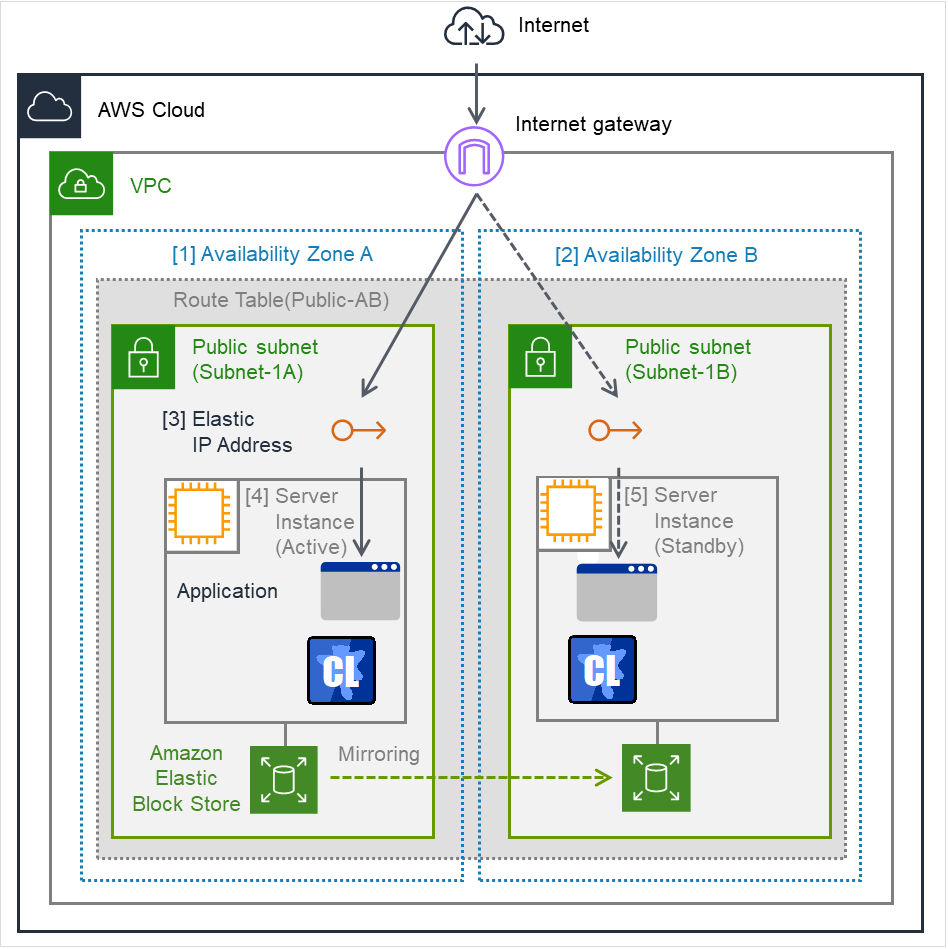
Fig. 6.1 System Configuration of the HA cluster based on EIP control¶
CIDR (VPC) |
10.0.0.0/16 |
|---|---|
Public subnet (Subnet-1A) |
10.0.10.0/24 |
Public subnet (Subnet-1B) |
10.0.20.0/24 |
6.1. Configuring the VPC Environment¶
Configure the VPC and subnet.
Create a VPC and subnet first.
-> Add a VPC and subnet in VPC and Subnets on the VPC Management console.
Configure the Internet gateway.
Add an Internet gateway to access the Internet from the VPC.
-> To create an Internet gateway, select Internet Gateways > Create internet gateway on the VPC Management console. Attach the created Internet gateway to the VPC.
Configure the network ACL and security group.
Specify the appropriate network ACL and security group settings to prevent unauthorized network access from in and out of the VPC.Change the network ACL and security group path settings so that the instances of the HA cluster node can communicate with the Internet gateway via HTTPS, communicate with Cluster WebUI and communicate with each other. The instances are to be placed on the public networks (Subnet-1A and Subnet-1B).-> Change the settings in Network ACLs and Security Groups on the VPC Management console.
For the port numbers that are used by the EXPRESSCLUSTER components, refer to the following:
Add an HA cluster instance.
Create an HA cluster node instance on the public networks (Subnet-1A and Subnet-1B).
When creating an HA cluster node instance, be sure to specify the setting to enable a public IP. If an instance is created without using a public IP, it is necessary to add an EIP or NAT needs to be prepared.
(This guide does not describe this case.)
To use an IAM role by assigning it to an instance, specify the IAM role.-> To create an instance, select Instances > Launch Instance on the EC2 Management console.
-> For details about the IAM settings, refer to the following:
Check the ID of the elastic network interface (ENI) assigned to each created instance.
- [4] Server Instance (Active), [5] Server Instance (Standby)
Write down the ENI ID (eni-xxxxxxxx) of each instance, because the ID is needed later for setting up the AWS elastic IP resource.
Use the following procedure to check the ENI ID assigned to the instance.
Select the instance to display its detailed information.
Click the target device in Network Interfaces.
Check Interface ID displayed in the pop-up window.
Add an EIP.
Add an EIP to access an instance in the VPC from the Internet.
-> To add an EIP, select Elastic IPs > Allocate new address on the EC2 Management console.
- [3] Elastic IP Address
Write down the Allocation ID (eipalloc-xxxxxxxx) of the added EIP, because the ID is needed later for setting up the AWS elastic IP resource.
Configure the route table.
Add the routing to the Internet gateway so that the AWS CLI can communicate with the regional endpoint via NAT.
The following routings must be set in the route table (Public-AB) of the public networks (Subnet-1A and Subnet-1B in the above figure).
Route table (Public-AB)
Destination
Target
Remarks
local
Existing by default
0.0.0.0/0
Internet Gateway
Add (required)
When a failover occurred, the AWS Elastic IP resource deassigns the EIP assigned to the active server instance by using the AWS CLI, and assign it to the standby server instance.
Configure other routings according to the environment.Add a mirror disk (EBS).
Add an EBS to be used as the mirror disk (cluster partition or data partition) as needed.
-> To add an EBS, select Volumes > Create volume on the EC2 Management console, and then attach the created volume to an instance.
6.2. Configuring the instance¶
Log in to each instance of the HA cluster and specify the following settings.
For the AWS CLI versions supported by EXPRESSCLUSTER, refer to the following:
Configure a firewall.
Change the firewall setting as needed.For the port numbers that are used by the EXPRESSCLUSTER components, refer to the following:Install the AWS CLI.
Download and install the AWS CLI.The installer automatically adds the path of the AWS CLI to the system environment variable PATH. If the automatic path addition fails, refer to "AWS Command Line Interface" of the AWS document to add the path.If the AWS CLI has been installed in an environment with EXPRESSCLUSTER already installed, restart the OS before operating EXPRESSCLUSTER.Register the AWS access key ID.
Start the command prompt as the Administrator user and run the following command:
> aws configure
Enter information such as the AWS access key ID to the inquiries.The settings to be specified vary depending on whether an IAM role is assigned to the instance or not.Instance to which an IAM role is assigned.
AWS Access Key ID [None]: (Press Enter without entering anything.) AWS Secret Access Key [None]: (Press Enter without entering anything.) Default region name [None]: <default region name> Default output format [None]: text
Instance to which an IAM role is not assigned.
AWS Access Key ID [None]: <AWS access key ID> AWS Secret Access Key [None]: <AWS secret access key> Default region name [None]: <default region name> Default output format [None]: text
For "Default output format", other format than "text" may be specified.If you specified incorrect settings, delete the folder%SystemDrive%\Users\Administrator\.awsentirely, and specify the above settings again.Prepare the mirror disk.
If an EBS has been added to be used as the mirror disk, divide the EBS into partitions and use each partition as the cluster partition and data partition.
For details about the mirror disk partition, refer to the following:
Install EXPRESSCLUSTER.
For the installation procedure, refer to "Installation and Configuration Guide".Store the EXPRESSCLUSTER installation media in the environment to which to install EXPRESSCLUSTER.(To transfer data, use any method such as Remote Desktop and Amazon S3.)After the installation, restart the OS.
6.3. Setting up EXPRESSCLUSTER¶
For details about how to set up and connect to Cluster WebUI, refer to the following:
This section describes how to add the following resources:
Mirror disk resource
AWS Elastic IP resource
AWS AZ monitor resource
AWS Elastic IP monitor resource
NP resolution (HTTP method)
For the settings other than the above, refer to "Installation and Configuration Guide".
Construct a cluster.
Start the cluster generation wizard to construct a cluster.
Construct a cluster.
Steps
Add a group resource.
Group definition
Create a failover group.
Steps
Mirror disk resource
Create the mirror disk resource according to the mirror disk (EBS) as needed.For details, refer to the following:Steps
Click Add in Group Resource List.
The Recovery Operation window is displayed. Click Next.
From Servers that can run the group, select the server name in the Name column, and click Add.
The Selection of Partition dialog box is displayed. Click Connect, select the data and cluster partitions, and click OK.
Perform steps 6 and 7 on the other node.
Return to the Details window and click Finish to complete setting.
AWS Elastic IP resource
Add an AWS Elastic IP resource that controls the EIP by using the AWS CLI.
For details, refer to the following:
Steps
Click Add in Group Resource List.
The Dependency window is displayed. Click Next without specifying anything.
Click Finish to complete setting.
Add a monitor resource.
AWS AZ monitor resource
Create the AWS AZ monitor resource to check whether the specified AZ is usable by using the monitor command.
For details, refer to the following:
-> Understanding AWS AZ monitor resourcesSteps
Click Add in Monitor Resource List.
Click Finish to complete setting.
AWS Elastic IP monitor resource
This resource is automatically added when the AWS Elastic IP resource is added.The health of the EIP address can be checked by monitoring the communication with the EIP address that is assigned to the active server instance.For details, refer to the following:-> Understanding AWS Elastic IP monitor resources
Apply the settings and start the cluster.
Select the Operation Mode on the drop down menu of the toolbar in Cluster WebUI to switch to the operation mode.
Select Start Cluster in the Status tab of Cluster WebUI and click.
Confirm that a cluster system starts and the status of the cluster is displayed to the Cluster WebUI. If the cluster system does not start normally, take action according to an error message.
For details, refer to the following:
7. Constructing an HA cluster based on DNS name control¶
This chapter describes how to construct an HA cluster based on DNS name control.
In the figure below, "Server Instance (Active)" and "Server Instance (Standby)" respectively represent the instance of the active server and that of the standby server.
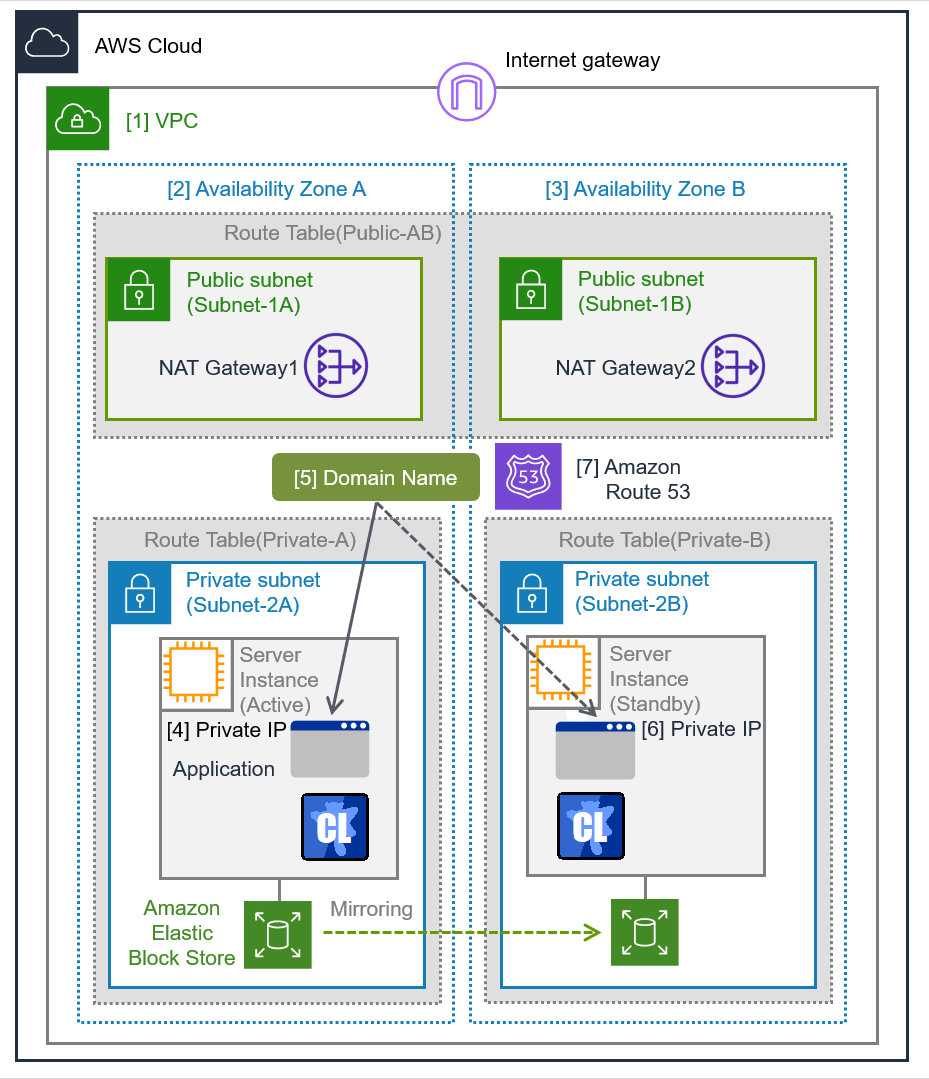
Fig. 7.1 System Configuration HA Cluster Based on DNS Name Control¶
CIDR (VPC) |
10.0.0.0/16 |
|---|---|
Domain Name |
srv.hz1.local |
Public subnet (Subnet-1A) |
10.0.10.0/24 |
Public subnet (Subnet-1B) |
10.0.20.0/24 |
Private subnet (Subnet-2A) |
10.0.110.0/24 |
Private subnet (Subnet-2B) |
10.0.120.0/24 |
7.1. Configuring the VPC Environment¶
Configure the VPC on the VPC Management console and EC2 Management console.
The IP addresses used in the figures and description are an example. In the actual configuration, use the actual IP addresses assigned to the VPC. When installing EXPRESSCLUSTER in the existing VPC, specify the appropriate settings such as adding a subnet if the number of subnets is insufficient.
Configure the VPC and subnet.
Create a VPC and subnet first.
-> Add a VPC and subnet in VPC and Subnets on the VPC Management console.
- [1] VPC
Write down the VPC ID (vpc-xxxxxxxx), which is needed later for adding the Hosted Zone.
Configure the Internet gateway.
Add an Internet gateway to access the Internet from the VPC.
-> To create an Internet gateway, select Internet Gateways > Create internet gateway on the VPC Management console. Attach the created Internet gateway to the VPC.
Configure the network ACL and security group.
Specify the appropriate network ACL and security group settings to prevent unauthorized network access from in and out of the VPC.
Change the network ACL and security group path settings so that the instances of the HA cluster node can communicate with the Internet gateway via HTTPS, communicate with Cluster WebUI, and communicate with each other. The instances are to be placed on the private networks (Subnet-2A and Subnet-2B).
-> Change the settings in Network ACLs and Security Groups on the VPC Management console.
For the port numbers that are used by the EXPRESSCLUSTER components, refer to the following:
Add an HA cluster instance.
Create an HA cluster node instance on the private networks (Subnet-2A and Subnet-2B).
To use an IAM role by assigning it to an instance, specify the IAM role.
-> To create an instance, select Instances > Launch Instance on the EC2 Management console.
-> For details about the IAM settings, refer to the following:
Add a NAT.
To perform the VIP control by using the AWS CLI, communication from the instance of the HA cluster node to the regional endpoint via HTTPS must be enabled.
To do so, create a NAT gateway on the public networks (Subnet-1A and Subnet-1B).
For more information on the NAT gateway, see the corresponding AWS document.
Configure the route table.
Add the routing to the Internet gateway so that the AWS CLI can communicate with the regional endpoint via NAT.
The following routings must be set in the route table (Public-AB) of the public networks (Subnet-1A and Subnet-1B in the above figure).
Route Table (Public-AB)
Destination
Target
Remarks
local
Existing by default
0.0.0.0/0
Internet gateway
Add (required)
The following routings must be set in the route tables (Private-A and Private-B) of the private networks (Subnet-2A and Subnet-2B in the above figure).
Route Table (Private-A)
Destination
Target
Remarks
local
Existing by default
0.0.0.0/0
NAT Gateway1
Add (required)
Route Table (Private-B)
Destination
Target
Remarks
local
Existing by default
0.0.0.0/0
NAT Gateway2
Add (required)
Configure other routings according to the environment.
Add a Hosted Zone
Add a hosted zone to Amazon Route 53.
- [7] Amazon Route 53 (Hosted Zone)
Write down the Hosted Zone ID, which is needed later for setting up the AWS DNS resource.
The reason that this guide includes the procedure to add Private Hosted Zone is to make it possible to access from the client within the VPC with the cluster located on the Private subnet. When access from internet is required, cluster must be located on Public subnet, therefore Public Hosted Zone will be added.
Add a mirror disk (EBS).
Add an EBS to be used as the mirror disk (cluster partition or data partition) as needed.
-> To add an EBS, select Volumes > Create Volume on the EC2 Management console, and then attach the created volume to an instance.
7.2. Configuring the instance¶
Log in to each instance of the HA cluster and specify the following settings.
For the AWS CLI versions supported by EXPRESSCLUSTER, refer to the following:
Configure a firewall.
Change the firewall setting as needed.For the port numbers that are used by the EXPRESSCLUSTER components, refer to the following:Install the AWS CLI.
Download and install the AWS CLI.The installer automatically adds the path of the AWS CLI to the system environment variable PATH. If the automatic path addition fails, refer to "AWS Command Line Interface" of the AWS document to add the path.If the AWS CLI has been installed in an environment with EXPRESSCLUSTER already installed, restart the OS before operating EXPRESSCLUSTER.Register the AWS access key ID.
Start the command prompt as the Administrator user and run the following command:
> aws configure
Enter information such as the AWS access key ID to the inquiries.The settings to be specified vary depending on whether an IAM role is assigned to the instance or not.Instance to which an IAM role is assigned.
AWS Access Key ID [None]: (Press Enter without entering anything.) AWS Secret Access Key [None]: (Press Enter without entering anything.) Default region name [None]: <default region name> Default output format [None]: text
Instance to which an IAM role is not assigned.
AWS Access Key ID [None]: <AWS access key ID> AWS Secret Access Key [None]: <AWS secret access key> Default region name [None]: <default region name> Default output format [None]: text
For "Default output format", other format than "text" may be specified.If you specified incorrect settings, delete the folder%SystemDrive%\Users\Administrator\.awsentirely, and specify the above settings again.Prepare the mirror disk.
If an EBS has been added to be used as the mirror disk, divide the EBS into partitions and use each partition as the cluster partition and data partition.
For details about the mirror disk partition, refer to the following:
Install EXPRESSCLUSTER.
For the installation procedure, refer to "Installation and Configuration Guide".
Store the EXPRESSCLUSTER installation media in the environment to which to install EXPRESSCLUSTER.(To transfer data, use any method such as Remote Desktop and Amazon S3.)After the installation, restart the OS.
7.3. Setting up EXPRESSCLUSTER¶
For details about how to set up and connect to Cluster WebUI, refer to the following:
This section describes how to add the following resources:
Mirror disk resource
AWS DNS resource
AWS AZ monitor resource
AWS DNS monitor resource
NP resolution (HTTP method)
For the settings other than the above, refer to "Installation and Configuration Guide".
Construct a cluster.
Start the cluster generation wizard to construct a cluster.
Construct a cluster.
Steps
Add a group resource.
Group definition
Create a failover group.
Steps
Click Next.
Mirror disk resource
Create the mirror disk resource according to the mirror disk (EBS) as needed.For details, refer to the following:-> Understanding mirror disk resourcesSteps
Click Add in Group Resource List.
The Recovery Operation window is displayed. Click Next.
From Servers that can run the group, select the server name in the Name column, and click Add.
The Selection of Partition dialog box is displayed. Click Connect, select the data and cluster partitions, and click OK.
Perform steps 6 and 7 on the other node.
Return to the Details window and click Finish to complete setting.
AWS DNS resource
Add the AWS DNS resource that controls the DNS name by using the AWS CLI.
For details, refer to the following:
Steps
Click Add in Group Resource List.
The Dependency window is displayed. Click Next without specifying anything.
The Recovery Operation window is displayed. Click Next.
Click Finish to complete setting.
Add a monitor resource.
AWS AZ monitor resource
Create an AWS AZ monitor resource to check whether the specified AZ is usable by using the monitor command.
For details, refer to the following:
Steps
Click Add in Monitor Resource List.
Click Finish to complete setting.
AWS DNS monitor resource
This resource is automatically added when the AWS DNS resource is added.Using AWS CLI commands, check whether the resource record set exists and the registered IP address can be obtained by resolving the DNS name.For details, refer to the following:
Apply the settings and start the cluster.
Select the Operation Mode on the drop down menu of the toolbar in Cluster WebUI to switch to the operation mode.
Select Start Cluster in the Status tab of Cluster WebUI and click.
Confirm that a cluster system starts and the status of the cluster is displayed to the Cluster WebUI. If the cluster system does not start normally, take action according to an error message.
For details, refer to the following:
-> How to create a cluster
8. Troubleshooting¶
This chapter describes the points to be checked and solutions if EXPRESSCLUSTER cannot be set up in the AWS environment.
Failed to start a resource or monitor resource related to AWS.
Confirm that the OS has restarted, the AWS CLI are installed, and the AWS CLI has been set up correctly.If the OS has been restarted when installing EXPRESSCLUSTER, the environment variable settings might be changed by installing the AWS CLI. In this case, restart the OS again.Failed to start the AWS Virtual IP resource.
- Cluster WebUI message
Failed to start the resource awsvip1. (51 : The AWS CLI command is not found.)
- Possible cause
Any of the following might be the cause.
The AWS CLI has not been installed, or the path does not reach aws.exe.
Solution
Check the following:
Confirm that the AWS CLI are installed.
Confirm that the paths to aws.exe are set to the environment variable PATH.
- Cluster WebUI message
- Possible cause
Any of the following might be the cause.
The AWS CLI has not been set up: aws configure has not been run.
The AWS CLI configuration file (file under
%SystemDrive%\Users\Administrator\.aws) could not be found. (A user other than Administrator ran aws configure.)The specified AWS CLI settings (such as a region, access key ID, and secret key) are not correct.
The specified VPC ID or ENI ID is invalid.
The regional endpoint has been stopped due to maintenance or failure.
An issue of the communication path to the regional endpoint.
Delay caused by the heavily loaded node.
- Solution
Check the following:
Correct the AWS CLI settings. Then confirm that the AWS CLI works successfully.
When the node is heavily loaded, remove the causes.
For an operation using an IAM role, check the settings on the AWS Management Console.
- Cluster WebUI message
- Possible cause
The specified VPC ID might not be correct or might not exist.
- Solution
Specify a correct VPC ID.
- Cluster WebUI message
- Possible cause
The specified ENI ID might not be correct or might not exist.
- Solution
Specify a correct ENI ID.
- Cluster WebUI message
- Possible cause
If the ReplaceRoute right of an IAM role can be exercised only on a route table specified in a resource in the IAM policy, the route table might have an error or lack of its settings.
- Solution
- Cluster WebUI message
- Possible cause
Any of the following might be the cause.
The AWS CLI command might not be able to communicate with the regional endpoint, due to a misconfiguration of the route table or NAT on the OS or due to a misconfiguration of the proxy server on EXPRESSCLUSTER.
Delay caused by the heavily loaded node.
- Solution
Check the following:
The routing for the NAT gateway has been set up.
The packet is not excluded by filtering.
Check the settings of the route table or NAT on the OS or those of the proxy server on EXPRESSCLUSTER.
When the node is heavily loaded, remove the causes.
- Cluster WebUI message
- Possible cause
The specified VIP address is not appropriate because it is within of the VPC CIDR range.
- Solution
Specify an IP address out of the VPC CIDR range as the VIP address.
The AWS Virtual IP resource is running normally, but ping cannot reach the VIP address.
- Cluster WebUI message
-- Possible cause
Source/Dest. Check of the ENI set to the AWS virtual ip resource is enabled.
- Solution
Disable Source/Dest. Check of the ENI set to the AWS virtual ip resource.
The AWS Virtual IP monitor resource enters the error state.
- Cluster WebUI message
Monitor awsvipw1 detected an error. (56 : The routing for VIP was changed.)
- Possible cause
In the route table, the target of the VIP address corresponding to the AWS virtual ip resource has been changed to another ENI ID for some reason.
- Solution
- When an error is detected, the AWS virtual ip resource is restarted automatically and the target is updated to a correct ENI ID.Check whether another HA cluster uses the same VIP address mistakenly and so on.
Failed to start the AWS Elastic IP resource.
- Cluster WebUI message
Failed to start the resource awseip1. (51 : The AWS CLI command was not found.)
- Possible cause
The AWS CLI has not been installed, or the path does not reach aws.exe.
- Solution
Check the following:
Confirm that the AWS CLI are installed.
Confirm that the paths to aws.exe are set to the environment variable PATH.
- Cluster WebUI message
- Possible cause
Any of the following might be the cause.
The AWS CLI has not been set up: aws configure has not been run.
The AWS CLI configuration file (file under
%SystemDrive%\Users\Administrator\.aws) could not be found. (A user other than Administrator ran aws configure.)The specified AWS CLI settings (such as a region, access key ID, and secret key) are not correct.
The specified VPC ID or ENI ID is invalid.
The regional endpoint has been stopped due to maintenance or failure.
An issue of the communication path to the regional endpoint.
Delay caused by the heavily loaded node.
- Solution
Check the following:
Correct the AWS CLI settings. Then confirm that the AWS CLI works successfully.
When the node is heavily loaded, remove the causes.
For an operation using an IAM role, check the settings on the AWS Management Console.
- Cluster WebUI message
- Possible cause
The specified EIP allocation ID might not be correct or might not exist.
- Solution
Specify a correct EIP allocation ID.
- Cluster WebUI message
- Possible cause
The specified ENI ID might not be correct or might not exist.
- Solution
Specify a correct ENI ID.
- Cluster WebUI message
- Possible cause
Any of the following might be the cause.
The AWS CLI command might not be able to communicate with the regional endpoint, due to a misconfiguration of the route table or NAT on the OS or due to a misconfiguration of the proxy server on EXPRESSCLUSTER.
Delay caused by the heavily loaded node.
- Solution
Check the following:
Confirm that a public IP is assigned to each instance.
Confirm that the AWS CLI works normally in each instance.
Check the settings of the route table or NAT on the OS or those of the proxy server on EXPRESSCLUSTER.
When the node is heavily loaded, remove the causes.
The AWS Elastic IP monitor resource enters the error state.
- Cluster WebUI message
Monitor awseipw1 detected an error. (52 : The EIP address does not exist.)
- Possible cause
The specified ENI ID and elastic IP have been deassociated for some reason.
- Solution
- When an error is detected, the AWS elastic ip resource is restarted automatically and the specified ENI ID and elastic IP are associated.Check whether another HA cluster uses the same EIP allocation ID mistakenly and so on.
Failed to start the AWS DNS resource
- Cluster WebUI message
Failed to start the resource awsdns1. (52: The AWS CLI command is not found.)
- Possible cause
The AWS CLI has not been installed, or the path does not reach aws.exe.
- Solution
Check the following:
Confirm that the AWS CLI are installed.
Confirm that the paths to aws.exe are set to the environment variable Path.
- Cluster WebUI message
- Possible cause
Any of the following might be the cause.
The AWS CLI has not been set up: aws configure has not been run.
The AWS CLI configuration file (file under
%SystemDrive%\Users\Administrator\.aws) could not be found. (A user other than Administrator ran aws configure.)The specified AWS CLI settings (such as a region, access key, and secrete key ID) are not correct.
The specified resource record set is invalid.
The regional endpoint has been stopped due to maintenance or failure.
An issue of the communication path to the regional endpoint.
Delay caused by the heavily loaded node.
Route 53 cannot be accessed or does not respond.
No VPC to which the HA instance belongs is added to a VPC targeted in the hosted zone of Route 53.
DNS name resolution is not enabled in the VPC to which the HA instance belongs.
The value of Resource Record Set Name is specified in capital letters.
The preferred DNS server is incorrectly set in the TCP/IPv4 properties of the corresponding network.
- Solution
Check the following:
Correct the AWS CLI settings. Then confirm that the AWS CLI works successfully.
When the node is heavily loaded, remove the causes.
In applicable Hosted Zone of the Route 53 Management Console, check that the necessary VPC is added to Associated VPC.
On the VPC Management Console, check that enableDnsSupport is enabled in the properties of the current VPC. If enableDnsSupport is intentionally disabled, set an appropriate DNS resolver for the record set added in the AWS DNS resource by the instance.
Specify the value of Resource Record Set Name in lowercase letters.
Correct the settings of the preferred DNS server.
If you are using a VPC endpoint, consider changing to any of the following methods: a NAT gateway, or proxy server. If you are not using a VPC endpoint, consult AWS.
For an operation using an IAM role, check the settings on the AWS Management Console.
- Cluster WebUI message
- Possible cause
The specified hosted zone ID might not be correct or might not exist.
- Solution
Specify a correct hosted zone ID.
- Cluster WebUI message
- Possible cause
Any of the following might be the cause.
The AWS CLI command might not be able to communicate with the regional endpoint, due to a misconfiguration of the route table or NAT on the OS or due to a misconfiguration of the proxy server on EXPRESSCLUSTER.
Delay caused by the heavily loaded node.
Delayed processing on the Route 53 endpoint side.
Delayed access to the instance metadata by the AWS CLI.
- Solution
Check the following:
The routing for the NAT gateway has been set up.
The packet is not excluded by filtering.
Check the settings of the route table or NAT on the OS or those of the proxy server on EXPRESSCLUSTER.
Despite the normal operation of the AWS DNS resource, it takes time to resolve names on clients.
- Cluster WebUI message
-
- Possible cause
Any of the following might be the cause:
- Due to the specification of Route 53, it takes up to 60 seconds to propagate its settings to all the authoritative servers. Refer to the following:Amazon Route 53 FAQsQ. How quickly will changes I make to my DNS settings on Amazon Route 53 propagate globally?
The OS-side resolver takes time.
- During a failover, the AWS DNS resource takes time to delete and create resource record sets.If the Delete a resource record set at deactivation checkbox is checked: A resource record set deleted on a failover source with the AWS DNS resource deactivated is created on a failover destination with the AWS DNS resource activated. This may delay name resolution.If the checkbox is not checked: No resource record set is deleted even with the AWS DNS resource deactivated or with the cluster stopped, and only the IP address of the corresponding resource record set is updated. This may shorten the time before names can be resolved. Even after the AWS DNS resource is deactivated or the cluster is stopped, names are resolved.
A large value of TTL for the AWS DNS resource.
- A small value of Start Monitor Wait Time for the AWS DNS monitor resource.If a name resolution is tried prior to the completion of Route 53 change propagation, the DNS returns NXDOMAIN (non-existing domain). In this case, the name resolution fails until the valid period of the negative cache (e.g. 900 seconds by default in Windows) expires.Therefore, with Start Monitor Wait Time set at a small value, a name resolution may take a long time.
- Solution
Check the following:
Review the settings of the OS-side resolver.
Uncheck the Delete a resource record set at deactivation checkbox of the AWS DNS resource.
Set TTL at a smaller value for the AWS DNS resource.
Set Start Monitor Wait Time at an allowable large value for the AWS DNS monitor resource.
The AWS DNS monitor resource enters the error state
- Cluster WebUI message
Monitor awsdnsw1 detected an error. (52: The resource record set in Amazon Route 53 does not exist.)
- Possible cause
Any of the following might be the cause.
In the hosted zone, the resource record set corresponding to the AWS DNS resource has been deleted for some reason.
Immediately after the AWS DNS resource is activated, if the AWS DNS monitor resource starts monitoring prior to the propagation of changed DNS settings in Route 53, the monitoring fails due to inability in resolving names. Refer to "Getting Started Guide -> "Notes and Restrictions" -> "Setting up AWS DNS monitor resources".
Of the IAM policy, the following is not set: route53:ChangeResourceRecordSets and route53:ListResourceRecordSets.
No VPC to which the HA instance belongs is added to a VPC targeted in the hosted zone of Route 53.
The DNS name specified in the Resource Record Set Name does not have a dot (.) at the end.
- Solution
Check the following:
No other HA clusters use the same resource record set by mistake. (If used, that is a cause of the deleted resource record set.)
The value of Start Monitor Wait Time of the AWS DNS monitor resource is set larger than that of the time to propagate changed DNS settings in Route 53.
The following is set in the IAM policy: route53:ChangeResourceRecordSets and route53:ListResourceRecordSets.
In applicable Hosted Zone of the Route 53 Management Console, the necessary VPC is added to Associated VPC.
The DNS name specified in the Resource Record Set Name is an FQDN, and has a dot (.) at the end.
- Cluster WebUI message
- Possible cause
In the hosted zone, the IP address of the resource record set corresponding to the AWS DNS resource has been deleted for some reason.
- Solution
Check whether another HA cluster uses the same resource record set mistakenly and so on.
- Cluster WebUI message
- Possible cause
The DNS query using the DNS name registered in the hosted zone as resource record set failed to check the name resolution for some reason.
- Solution
Check the following:
If there are no errors in the resolver settings.
If there are no errors in the network settings.
If the domain query is set to refer to Amazon Route 53 name server (NS) based on the NS record setting of registrar when Public Host Zone is used.
- Cluster WebUI message
- Possible cause
The IP address obtained by name resolution check with the DNS name registered in the Hosted Zone as the resource record set is not correct.
- Solution
Check the following:
If the resolver setting is correct.
If there are no entries related to the DNS name in the hosts file.
The AWS DNS monitor resource enters the warning or error state.
- Cluster WebUI message
- [Warning]
Monitor awsdnsw1 is in the warning status. (151 : Timeout occurred)
- [Error]
Monitor awsdnsw1 detected an error. (51 : Timeout occurred)
- Possible cause
Any of the following might be the cause.
The AWS CLI command might not be able to communicate with the regional endpoint, due to a misconfiguration of the route table or NAT on the OS or due to a misconfiguration of the proxy server on EXPRESSCLUSTER.
Delay caused by the heavily loaded node.
Delayed processing on the Route 53 endpoint side.
Delayed access to the instance metadata by the AWS CLI.
- Solution
Check the following:
The routing for the NAT gateway has been set up.
The packet is not excluded by filtering.
Check the settings of the route table or NAT on the OS or those of the proxy server on EXPRESSCLUSTER.
- The value of Timeout for Monitor (common) in the AWS environment is set at or larger than that of the time required for running the AWS CLI. Measure the required time by manually executing the AWS CLI. The AWS DNS monitor resource runs the following AWS CLI:
> aws route53 list-resource-record-sets
- For an operation using an IAM role: When running the AWS CLI, the AWS DNS resource and monitor resource of EXPRESSCLUSTER acquires credentials (such as an access key ID) from the instance metadata.Check if access to the instance metadata is not delayed, by manually determining the time required for executing the commands below.If running either of the commands is delayed, the access to the instance metadata is delayed.If the delay is confirmed, allow an IAM user to access the instance metadata--by running the aws configure command to add the settings of the access key ID and secret access key to each of the cluster nodes. This may reduce the occurrence of timeouts.- On each of the cluster nodes, run the curl command or use a browser to access the URL: http://169.254.169.254/latest/meta-data/- On any of the cluster nodes, run the command: aws configure list
The AWS AZ monitor resource enters the warning or error state.
- Cluster WebUI message
- [Warning]
Monitor awsazw1 is in the warning status. (105 : the AWS CLI command failed.)
- [Error]
Monitor awsazw1 detected an error. (5 : the AWS CLI command failed.)
- Possible cause
Any of the following might be the cause.
The AWS CLI has not been set up: aws configure has not been run.
The AWS CLI configuration file (file under
%SystemDrive%\Users\Administrator\.aws) could not be found. (A user other than Administrator ran aws configure.)The specified AWS CLI settings (such as a region, access key ID, and secret key) are not correct.
- (For an operation using an IAM role) An IAM role has not been set to the instance.Access the URL below from the corresponding instance and then check whether the given IAM role name is displayed. If the message "404 Not Found" appears, no IAM role has been set.
The specified AZ is invalid.
The regional endpoint has been stopped due to maintenance or failure.
An issue of the communication path to the regional endpoint.
Delay caused by the heavily loaded node.
- Solution
Check the following: - Correct the AWS CLI settings. Then confirm that the AWS CLI works successfully. - When the node is heavily loaded, remove the causes. - If the warning frequently appears, it is recommended to change to Disable recovery action (Display warning). Even if you do it, it is possible to detect errors except those caused by delayed response and by failure in running the AWS CLI on the monitor resource. - For an operation using an IAM role, check the settings on the AWS Management Console.
- Cluster WebUI message
- [Warning]
- [Error]
- Possible cause
The specified AZ might not be correct or might not exist.
- Solution
Specify a correct AZ.
- Cluster WebUI message
- [Warning]
- [Error]
- Possible cause
Any of the following might be the cause.
The AWS CLI command might not be able to communicate with the regional endpoint, due to a misconfiguration of the route table or NAT on the OS or due to a misconfiguration of the proxy server on EXPRESSCLUSTER.
Delay caused by the heavily loaded node.
- Solution
Check the following:
The routing for the NAT gateway has been set up.
The packet is not excluded by filtering.
Check the settings of the route table or NAT on the OS or those of the proxy server on EXPRESSCLUSTER.
When the node is heavily loaded, remove the causes.

